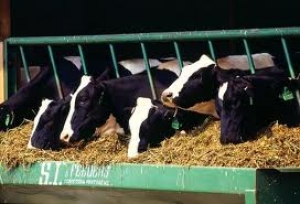Dairy farming

Lamar Adams, dairy cattle specialist with the Mississippi State University Extension Service, said production costs are at or near record highs and milk prices are down about 21 per cent from last year primarily due to high levels of domestic and global milk production.
“Dairy farmers are experiencing a critical financial squeeze because of high production costs and falling milk prices,” Mr Adams said. “2009 was a financially terrible year for dairy farmers, and those who remained in business tried to recover in 2010 and 2011.
“Milk prices hit record-high levels in 2011, but many market analysts say domestic and global market conditions are positioned to continue placing downward pressure on milk prices and dairy farm profitability for the remainder of 2012 and into 2013,” he said.
Mississippi dairy farmers are receiving about $17.50 per hundredweight, or $1.51 a gallon, for milk. In 2011, they received $22.09 per hundredweight, or $1.90 a gallon.
John Michael Riley, MSU Extension agricultural economist, said dairy production is above 2011 levels, largely due to more dairy cows on hand and higher milk production per cow.
“This has led to increased supplies, which has pressured prices of milk and all milk products,” he said.
In 2007, the state had 178 dairies. Last year, there were 120 dairy farms, and as of Jan. 1, just 109 could be found in Mississippi. The heaviest concentration of dairy farms are in the Walthall, Marion, Pike and Lincoln county area.
Two commercial milk processing plants serve the state -- LuVel in Kosciusko and Borden in Hattiesburg. Adams said most of the state’s milk is marketed through Dairy Farmers of America, the largest farmer-owned dairy cooperative in the nation. Most of the state’s milk is bottled and sold as a beverage.
“We are a milk-deficit state, as is the rest of the Southeast,” Mr Adams said. “Milk is brought into Mississippi from the other regions of the country for processing and marketing to meet consumer demand.”
Mississippi dairy cows deal with heat stress and a shortage of high-quality forages such as alfalfa, which does not grow very well in the Southeast. High-quality feeds promote high milk production, but cows eat less in hot weather to stay cool, resulting in less milk production.
Mississippi dairy cows produced an average of 14,571 pounds of milk per cow in 2011, or 5.6 gallons a day. The national per-cow average is 21,000 pounds annually.
“Mississippi dairy farmers face tremendous challenges during the spring, summer and fall months with problems associated with heat stress on their cattle,” Mr Adams said. “However, they rise to these challenges and do a good job of keeping their animals comfortable by providing plenty of shade, well-ventilated buildings, barns and other cooling structures, and easy access to feed and plenty of cool, fresh drinking water.”
Dairy producers also keep their cows cool during the milking process with fans and water sprinkling systems that use evaporative cooling to keep the cows comfortable.
Rocky Lemus, Extension forage and grazing systems specialist, said feed costs are a large part of milk’s production cost. As much as 40 percent of a dairy cow’s diet comes from hay, silage or commodity feeds, and farmers must purchase this if they do not produce it.
“Mild winter weather allowed pastures to maintain a more uniform forage production of annual ryegrass, which shortened the feeding cycle,” Mr Lemus said. “On the other hand, warmer days and cooler nights made Bermudagrass grow, but it has a very low yield with early seed heading and reduced forage quality.”
The environmental conditions also triggered competition between aggressively growing annual ryegrass and warm-season grasses breaking dormancy. Mr Lemus said corn demand for ethanol production is driving feed prices, while high fertiliser prices are driving forage production costs.
“Fertilisation accounts for nearly half of the expense of making hay,” Lemus said. “Dairy producers, like any other hay producers, need to adopt strategic fertiliser practices to reduce inputs.”























